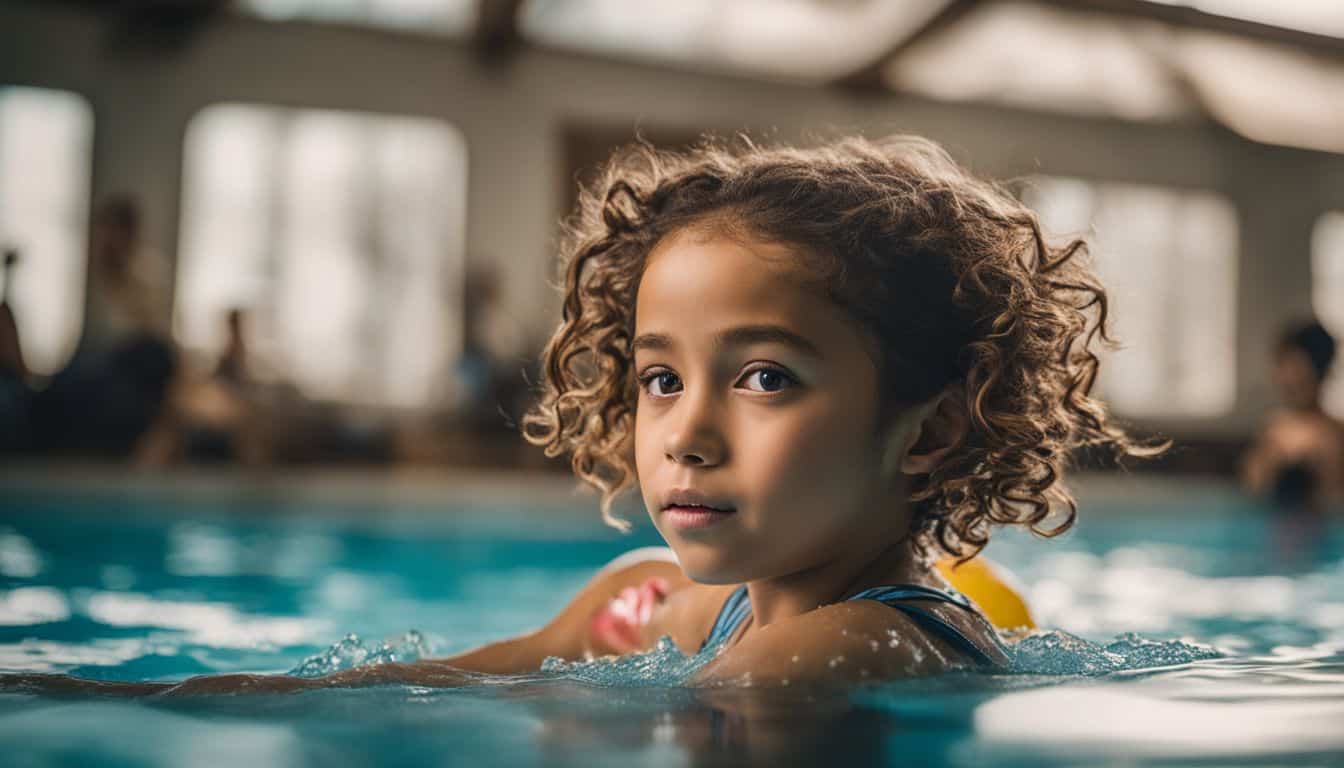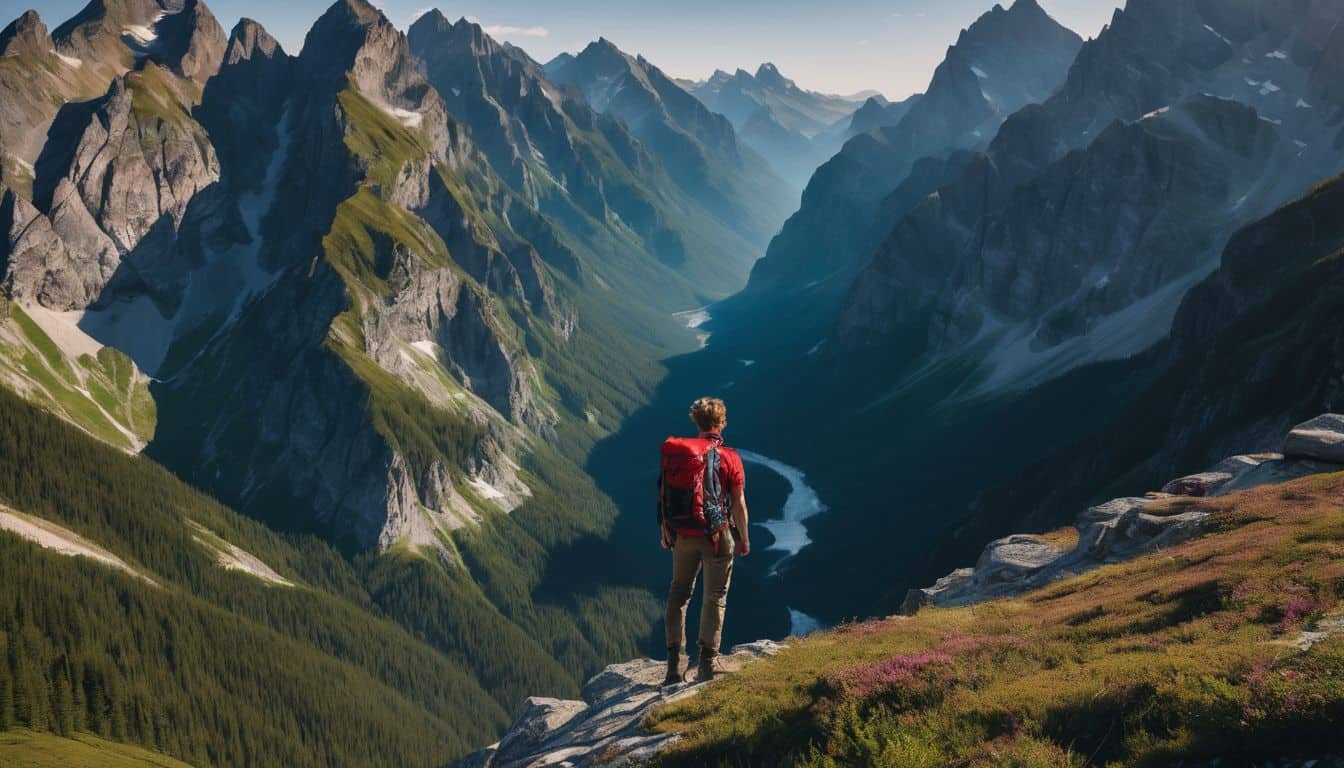Are you drawn to the thrill of water-based adventures, but find your nerves getting the better of you because of uncertain swimming skills? Believe me, I completely understand. Just like you, I once felt my lackluster abilities were holding me back from truly experiencing and enjoying these activities.
It kicked off an enduring quest for me – mastering survival swimming not just for unbridled joy but also to ensure absolute safety. After countless hours spent in research, personal practice and overcoming my own fears, I’ve managed to learn numerous techniques that have boosted both my confidence and competence in water survival skills.
So come on in – together let’s navigate this exciting journey into life-saving aquatic capabilities!
Key Takeaways
- Survival swimming lessons are essential for everyone, as they teach necessary skills and improve confidence in the water.
- Understanding the principles of survival swimming, such as floating effectively and mastering breathing exercises, is crucial for staying safe.
- Learning basic strokes like freestyle and backstroke, as well as advanced techniques like butterfly and breaststroke, can help you excel in survival swimming.
- Being prepared for unlikely situations by learning emergency preparedness techniques and using proper safety gear is important to ensure your safety while swimming.
The Value of Survival Swimming Lessons
Survival swimming lessons are essential for everyone, as they not only teach the necessary skills to stay safe in and around water but also provide numerous benefits such as improved confidence, physical fitness, and overall well-being.
The importance of swim lessons
Swim lessons are a big deal. They help stop drowning which is a key cause of death. If you know how to swim, you can take care of yourself in the water. You get more brave and confident too.
Swim classes not only teach basic skills but also show ways to save energy in case we are stuck in water for a long time. The best part? Even little kids can learn these survival tricks and techniques! This makes swimming lessons very valuable in saving lives.
Benefits of private/semi-private swim lessons
There is much to gain from private or semi-private swim lessons.
- First, these lessons give you personalized instruction. This means the teacher focuses on you and your needs. No two people learn in the same way, and this style of teaching helps you to learn fast.
- Second, if you have a friend or sibling who wants to learn too, they can join you. It can make learning more fun.
- Third, if you live in Albany, New York, there is a place called Excel Aquatics that gives private lessons for kids aged 3-13 years.
- Fourth, these lessons are very handy. You don’t need to go far away to a big swim place. You can get top-notch teaching right where you are.
- Finally, we must not forget that “survival” swim lessons are not about scare tactics. Some people think they need to feel like they might drown to learn how to swim. But this isn’t true and can be harmful too.
Our summer backyard swim program
Our summer backyard swim program is a hit. Every year, for seven years now, I have run it in the Capital Region. We make swimming fun and convenient by bringing lessons to your own pool! The goal of this program is not just learning how to swim.
It’s also about teaching you survival skills that could save your life one day in water accidents. Swimming is important — it keeps us safe and fit, and it’s a great way to enjoy the summer heat! With our backyard swim program, you learn directly from skilled teachers who make sure you master survival techniques while having fun at the same time.
Water safety and the importance of swim lessons
Learning to swim is crucial for staying safe in and around water. It’s not just about knowing how to swim; it also involves understanding water safety, developing safe attitudes and behaviors, and being aware of drowning prevention strategies.
Swim lessons are essential because they provide the knowledge, skills, and confidence needed to handle oneself in the water. They teach children survival skills and help prevent exhaustion by teaching them how to conserve energy while swimming.
It’s important to note that “survival” swim lessons can be traumatic for children, so it’s recommended to opt for developmentally-appropriate alternatives that prioritize their well-being.
Principles and Basics of Survival Swimming Techniques
Survival swimming techniques are essential skills that can save lives in emergency situations. To learn these techniques, it is important to understand the principles and basics of survival swimming.
One key principle is learning how to float effectively in the water. Floating allows you to conserve energy and rest while waiting for help. Another principle is mastering breathing exercises, such as taking deep breaths before going underwater or learning how to control your breathing while swimming.
In terms of basic swimming techniques, it’s important to start with the fundamentals like kicking and arm movements. These movements help propel you through the water efficiently and build up your stamina.
Additionally, sculling is a technique that involves moving your hands in a figure-eight motion at the surface of the water. This helps reduce drag and improve your overall swimming power.
By understanding these principles and practicing basic survival swimming techniques, you can become more confident in the water and be better prepared for any unexpected situations that may arise.
Remember that safety should always be a top priority when engaging in any water-related activities.
How to Swim
To learn how to swim, start by getting comfortable in the water and practicing basic strokes like freestyle and backstroke. Gradually progress to more advanced techniques such as butterfly and breaststroke while also learning important survival skills like treading water and floating on your back.
Don’t forget to be prepared for unlikely situations by taking safety precautions and always swimming with a buddy.
Getting comfortable in the water
When learning how to swim, getting comfortable in the water is an important first step. It’s normal to feel a bit nervous or unsure at first, but with practice and patience, you can develop confidence in the water.
Start by slowly entering the water, taking deep breaths to relax yourself. Use floats or other buoyancy aids if needed to help you feel more secure. Take your time and focus on getting used to the sensation of being in the water.
Remember, it’s okay to go at your own pace and take breaks when needed. With persistence and determination, you’ll soon become more comfortable in the water and ready for the next steps in learning how to swim.
Beginning strokes and treading water
Learning how to swim can be an important skill for survival. Here are some beginning strokes and treading water techniques to get you started:
- Floating: Practice floating on your back in the water. Relax your body and let your arms and legs float freely.
- Backstroke: This stroke involves floating flat on your back and using a flutter kick with your legs. Keep your arms relaxed and extended above your head, moving them in a circular motion.
- Front Stroke (Freestyle Swimming): This is a starting stroke where you swim on your stomach. Kick your legs in a fluttering motion while alternating pulling your arms through the water.
- Treading Water: Treading water is the technique used to stay in one place while keeping your head above water. Keep your body vertical and use a gentle scissor kick with your legs while moving your arms in small circles.
Learning advanced techniques
Learning advanced techniques is an important part of survival swimming. Here are some tips to help you excel:
- Master the crawl stroke: The crawl stroke, also known as freestyle, is the fastest and most efficient swimming technique. Practice your arm movements and breathing to swim smoothly through the water.
- Develop your endurance: Swimming long distances requires stamina. Gradually increase the distance you swim to improve your endurance and build strength in your muscles.
- Master breathing techniques: Proper breathing is crucial for efficient swimming. Practice exhaling underwater and taking quick breaths when needed to maintain a steady rhythm.
- Perfect your technique: Focus on your body position, arm movements, and kicking technique. Pay attention to details like hand placement, body rotation, and kick timing to improve your overall swimming performance.
- Master the crawl stroke
- Develop your endurance
- Master breathing techniques
- Perfect your technique

Being prepared for unlikely situations
Being prepared for unlikely situations is essential when it comes to survival swimming. You never know what could happen, so it’s important to be ready for anything. One way to prepare is by learning emergency preparedness techniques, such as battle simulation training.
This type of training can teach you how to stay calm and react quickly in high-pressure situations. It’s also crucial to understand the importance of personal flotation devices and proper safety gear.
Until you gain enough water experience and comfort, using these tools can help keep you safe. Remember, always swim with others and avoid venturing out onto ice or into moving water alone.
Tips and Advice
Learn from experts and discover helpful videos for improving your survival swimming techniques. Get essential tips and warnings to stay safe in the water. Dive into this section to enhance your skills and become a stronger swimmer.
Advice from experts
Survival swimming techniques can be improved with advice from experts. Here are some valuable tips to help you excel:
- Instructors suggest avoiding the use of “learn to swim” devices in pools, as they can create a false sense of security.
- To enhance swim safety, supervisors should actively engage with swimmers rather than just watching from the sideline.
- Taking swim lessons and gaining water competency is crucial for mastering survival swimming techniques.
- It’s important not to swim alone, especially in unfamiliar or dangerous waters.
- Beginners are encouraged to start in calm, controlled environments instead of moving water.
- Until enough experience is gained, it’s essential to use proper safety gear such as life jackets or floatation aids.
- Teaching children five basic survival swimming skills can significantly reduce the risk of accidents.
Helpful videos
I found some helpful videos that can improve your swimming technique. These videos provide tips and advice on how to swim faster and with less effort, especially when it comes to breaststroke technique.
They demonstrate the six principles that can help you excel in the water. You’ll also find videos on water safety, survival skills, and rescue techniques. By watching these videos, you can learn from experts and enhance your swimming abilities.
So grab your goggles and dive into these useful resources!
Other helpful tips and warnings
Here are some additional tips and warnings to keep in mind when it comes to survival swimming:
- Always swim with a buddy. Having someone with you can provide an extra layer of safety and support in case of any emergencies.
- Be aware of your surroundings, including currents, waves, and any hazardous objects or obstacles in the water.
- Practice floating techniques regularly to build your confidence and ability to stay afloat for extended periods of time.
- Learn different breathing techniques that can help you conserve energy and stay calm while swimming long distances.
- Take safety precautions such as wearing a life jacket or using floatation devices when necessary, especially if you are not a strong swimmer.
- Be mindful of warning signs indicating fatigue or distress, and know when it’s time to take a break or seek assistance.
- Stay updated on water safety guidelines and regulations in your area. Familiarize yourself with local programs or resources that offer swim lessons or water safety education.
Safety Training for Swimming Coaches
Swimming coaches undergo safety training to ensure they have the knowledge and skills to keep their athletes safe in the water.
Principles of growth and development
Understanding the principles of growth and development is crucial for swimming coaches to effectively train athletes. As a coach, I am trained to recognize the different stages of child development and adapt my coaching techniques accordingly.
By understanding concepts such as motor skills, cognitive development, and age-appropriate coaching, I can ensure that I provide the right guidance for each athlete’s individual needs.
The USA Swimming website is a valuable resource that keeps me updated on the latest coaching methods based on these principles. By focusing on skill progression and talent identification, I can help athletes reach their full potential while also fostering their physical and psychological development.
USA Swimming guidelines
USA Swimming has established guidelines for the safety training of swim coaches. These guidelines aim to ensure that coaches are equipped with the necessary knowledge and skills to handle potential hazards in and around the water.
Safety Training for Swim Coaches (STSC) consists of an online course, a test, and an in-water skills session. The American Red Cross also offers a program specifically designed for swim coach safety training.
In addition to these training programs, USA Swimming provides valuable resources and information on Safe Sport issues, offering guidance to coaches, parents, and athletes alike.
Methods appropriate for the level of the athletes
As a survival enthusiast, I understand the importance of using methods that are appropriate for the level of athletes when it comes to swimming. It’s crucial for coaches to have a deep understanding of skill development and training techniques.
By staying updated on the latest coaching methods and sports science research, coaches can ensure that they are providing effective training strategies for their athletes.
Safety training is also an essential aspect of coaching swimming. Coaches should be knowledgeable in water safety education and lifesaving skills. They can incorporate this information into their coaching practices to promote a safe swimming environment.
When working with athletes at different levels, it’s important to focus on skill acquisition before emphasizing endurance training. Teaching proper stroke technique and getting athletes comfortable in the water lays a strong foundation for success in swim team competitions.
Infant Survival Swimming Lessons
Infant survival swimming lessons are a crucial part of our program, with lessons offered five days a week to ensure that infants become comfortable and skilled in the water.
Lessons 5 days/week
I offer infant survival swimming lessons five days a week. This consistent schedule allows for regular practice and progression in developing swim-float-swim skills. By attending lessons frequently, infants can build their confidence in the water, improve their breath control, and learn important safety precautions.
It’s important to note that while these lessons are beneficial for child development, they may not be suitable for every child due to the potential for trauma and fear of water or distrust of instructors.
Swim-float-swim skills
Infant Survival Swimming Lessons focus on teaching swim-float-swim skills to babies. Through repetitive exercises and verbal encouragement, these lessons aim to make the child a skilled survival floater or swim-float-swimmer within weeks.
Programs like ISR (Infant Swimming Resource) teach babies how to float until they can be rescued, while the Survival Swim method focuses on survival and self-rescue. These skills are crucial for water safety, especially in preventing water-related emergencies.
Learning swim-float-swim skills at an early age can give parents peace of mind knowing that their little ones have the ability to save themselves if needed.
Water Safety Tips
Ensure water safety at home by securing fences or barriers around pools, never leaving children unattended near water, and teaching them basic swimming skills from a young age.
Programs in Albany and Schenectady
I am excited to share with you the programs we offer in Albany and Schenectady, NY. Our programs focus on water safety tips and survival swimming techniques. We are dedicated to promoting water safety for both children and adults.
At Excel Aquatics in Albany, we provide swim lessons and programs tailored to the needs of all skill levels. Whether you are a beginner or looking to compete, our blog offers valuable information on lessons, tips, techniques, competitions, and more.
It is important to note that our programs require access to water such as the ocean, lake, or river. So come join us in Albany or Schenectady and let’s dive into the world of swimming!
Tips for water safety at home
Water safety is crucial, even at home. Here are some important tips to keep in mind:
- Always supervise children when they are near water, whether it’s a pool, bathtub, or even a bucket of water.
- Install barriers such as fences and gates around your backyard pool to prevent unsupervised access.
- Keep a close eye on young children during bath time to prevent accidental drowning.
- Teach your children about the buddy system and never allow them to swim alone.
- Learn CPR (cardiopulmonary resuscitation) so you can act quickly in case of an emergency.
- Avoid engaging in breath – holding games as they can be dangerous and lead to accidents.
- Make sure everyone in the family knows how to use life jackets properly and always wear one when boating or participating in water activities.
How to Excel at Swimming
To excel at swimming, you can focus on learning the crawl stroke, developing your endurance, mastering breathing techniques, and perfecting your technique.
Learning the crawl stroke
Learning the crawl stroke, also known as freestyle swimming, is a key skill to excel in swimming. The crawl stroke technique is considered to be the most efficient in terms of energy demands.
It’s important to start with this stroke when learning how to swim. As a survival enthusiast, mastering the crawl stroke will not only help you improve your endurance but also enhance your overall swimming technique.
By focusing on proper breathing techniques and perfecting your form, you’ll be able to swim longer distances with less effort. Remember that the Western New York Swimming Instructor Certification Course prioritizes teaching the crawl stroke first due to its efficiency and effectiveness.
Developing your endurance
When it comes to developing endurance in swimming, there are a few key things to focus on. First of all, mixing up your training routine by incorporating both sprints and slow swims can help improve your stamina over time.
Additionally, working on your breathing and increasing lung capacity outside of the pool can have a positive impact on your cardiovascular fitness. Another strategy is to try different strokes during your training sessions as this can help you build muscular endurance and improve overall aerobic capacity.
Training with equipment such as pull buoys or fins can also contribute to building endurance by adding resistance to your workouts. Finally, interval training is a great way to push yourself and improve endurance in any type of exercise – whether it’s swimming, biking or running.
Mastering breathing techniques
To excel at swimming, mastering breathing techniques is crucial. By doing respiratory exercises and training your lung capacity, you can improve your ability to breathe efficiently in the water.
One helpful technique is to practice breath control by holding your breath underwater for longer periods of time during drills. Another important aspect is finding a breathing pattern that works for you while swimming, such as taking a breath every 6 or 7 strokes to conserve energy.
Additionally, incorporating dryland breathing exercises into your routine can further enhance your lung capacity and overall performance in the water. Remember, developing good breathing rhythm and efficiency will greatly contribute to your success as a swimmer.
Perfecting your technique
To excel at swimming, perfecting your technique is key. It’s important to remember that water is much denser than air, so slipping through the water smoothly can make a big difference in your swimming ability.
Incorporating both sprints and slow swims into your training routine can help improve endurance swimming. Training your breathing and increasing lung capacity through activities like running or lifting can also enhance your endurance in the water.
To refine your freestyle stroke, focus on maintaining a neutral head position and swimming on your sides. By constantly working on improving these techniques, you’ll be able to elevate your swimming skills and become an even better swimmer.
Quizzes and Expert Interviews
Test your knowledge with fun quizzes and gain valuable insights from expert interviews.
Test your knowledge
Let’s see how much you’ve learned about survival swimming techniques! Take our quiz to assess your knowledge and understanding. Test yourself on the principles and basics of survival swimming, as well as tips and advice from experts.
See if you can determine whether you’re ready to excel in the water. Put your skills to the test and find out how much you comprehend about this essential skill for survival enthusiasts like yourself.
Get advice from experts
I’ve got some great news for you! In this article, you’ll be able to get advice from experts in survival swimming techniques. These experts will share their insights and knowledge through quizzes and expert interviews.
You’ll have the opportunity to test your knowledge and learn from those who know best. So if you’re looking to excel in survival swimming, make sure to take advantage of the valuable advice provided by these experts.
They can help you enhance your skills and stay safe in the water. Don’t miss out on this fantastic opportunity!
Conclusion on Survival Swimming Techniques
In conclusion, mastering survival swimming techniques is essential for anyone who wants to excel in the water. By learning basic skills like floating and proper breathing, individuals can swim effectively and safely.
Whether you’re a beginner or an advanced swimmer, practicing these techniques will help you become more confident and prepared for any aquatic situation. So dive in, keep practicing, and remember that with determination and effort, you can become a skilled survivor in the water!
FAQs on Survival Swimming Techniques
1. What are survival swimming techniques?
Survival swimming techniques are skills that can help you stay safe and keep afloat in the water during emergencies or challenging situations.
2. Are survival swimming techniques difficult to learn?
No, survival swimming techniques can be learned by individuals of different age groups with proper training and practice.
3. What are some basic survival swimming techniques?
Some basic survival swimming techniques include treading water, floating on your back, using the sculling technique for propulsion, and maintaining a calm mindset in the water.
4. Do I need any special equipment to practice survival swimming techniques?
No, you don’t need any special equipment to practice most survival swimming techniques. However, having a life jacket or floatation device can provide additional safety support while learning these skills.
5. How can I excel in survival swimming techniques?
To excel in survival swimming techniques, it is important to receive proper instruction from a qualified swim instructor or lifeguard and regularly practice these skills in supervised environments like pools or designated open waters.





Leave a Reply